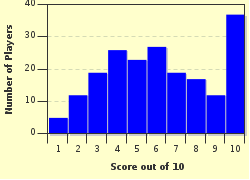Quiz Answer Key and Fun Facts
1. In the movies "Elizabeth" and "Elizabeth: The Golden Age", Oscar-winning actor Geoffrey Rush portrayed an aide to Queen Elizabeth I, considered to be the "father" of modern espionage. Among other intelligence, his spies produced the evidence that led to the execution of Mary, Queen of Scots. Who was he?
2. One of the most villainous spies on film was the Lady de Winter, simply known as "Milady", a spy for Cardinal Richelieu in France during the early 1600s, who used her unquestioned beauty to further her espionage. In what story, which has been filmed multiple times, did she appear?
3. Director John Sturges made a 1955 movie, "The Scarlet Coat", about the most famous real-life British spy of the American Revolution, who blundered his way into capture in the middle of his most important mission. Who was he?
4. This early talking picture from 1931, featuring Greta Garbo, was a worldwide commercial smash that told a story about a beautiful and promiscuous Dutch exotic dancer who worked as a double agent for the Germans during World War I. What was the name of this movie?
5. This 1935 British spy film was often viewed as the prototype of the modern "wrong man" movie, with Richard Hannay (Robert Donat) as the innocent who was told too much by the spy Annabella Smith. This led to his lone pursuit of a foreign government's spy ring that was trying to smuggle airplane plans out of England ... while being pursued for murder. Which classic Alfred Hitchcock film was this?
6. In a 1987 movie directed by John Sayles, Bob Gunton played a small-town miner and restaurant operator named C.E. Lively, who was a spy for the coal-mining companies against the United Mine Workers union in the years after World War I. What movie, set in the West Virginia coal mining region, did this appear in?
7. 1952's "5 Fingers", directed by Joseph L. Mankiewicz, was based on the true story of Elyesa Bazna (renamed Ulysses Diello in the movie), a Nazi spy in Turkey during World War II who went by the code name Cicero. What was Cicero's job that gave him access to top-secret British documents?
8. Nazi commandos raided England during World War II in John Sturges' 1975 film "The Eagle Has Landed", about a German attempt to capture or assassinate Winston Churchill based on information provided to them by spies in England. One of the spies, loosely based on a real person, was Liam Devlin, an IRA leader who pretended to be a game warden. Who portrayed Devlin?
9. A post-Word War II spy movie directed by Alfred Hitchcock revolved around a choice made by secret agent T.R. Devlin (Cary Grant): forcing Alicia (Ingrid Bergman), the woman he loved and whom he had recruited as part of his spy network, to seduce and eventually marry Alex Sebastian (Claude Rains), one of the ex-Nazis in Brazil upon whom he was spying. What movie was it?
10. Spy movies generally focus on drama instead of comedy, but there have been exceptions. In this famous 1927 silent film, a Southerner named Johnny (Buster Keaton) had to rescue both his beloved locomotive and his girlfriend Annabelle Lee, who were both captured by Union spies. Keaton also co-wrote and co-directed. What was it called?
Source: Author
AyatollahK
This quiz was reviewed by FunTrivia editor
Nannanut before going online.
Any errors found in FunTrivia content are routinely corrected through our feedback system.

